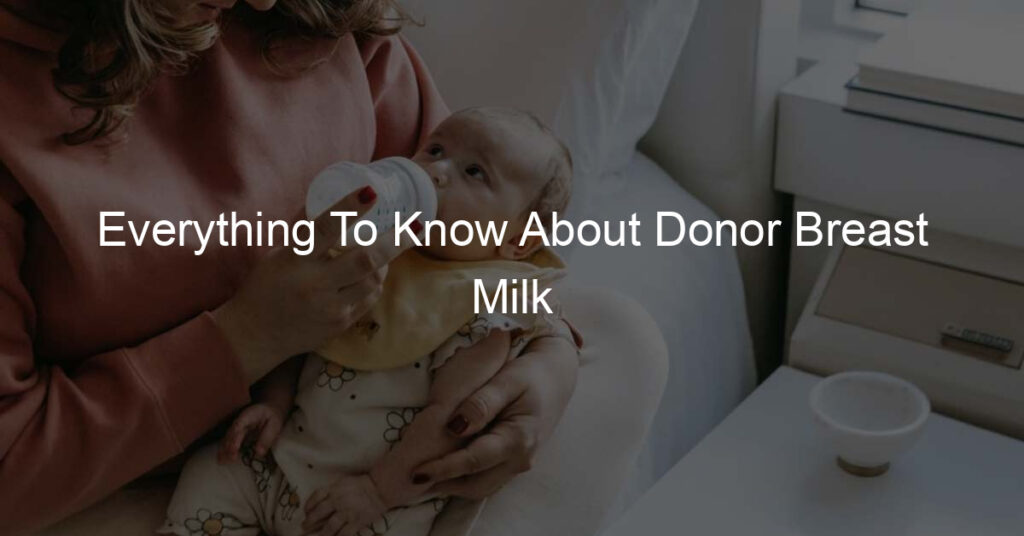If you are considering using donor breast milk for your baby, there are a few things you should know. Donor milk can be a great option for babies who cannot tolerate formula or who have other medical conditions. Here is everything you need to know about donor breast milk.
What are the benefits of using donor breast milk?
Donor breast milk is a solution for many families who are unable to provide their infants with natural breast milk directly from the mother. Donor milk comes with numerous advantages, and health experts recognize its importance in delivering both physical and cognitive benefits to developing babies. It contains essential nutrients, fatty acids, and antibodies that help babies build a stronger immune system.
Furthermore, studies have demonstrated that donor milk can reduce significantly the risk of infection or skin problems in preterm and low-birthweight newborns when compared to formula-fed babies. Moreover, the remarkably nutrient-dense composition of donor breast milk has been linked to improved social behaviors, intellectual achievements, and enhanced emotional development in later childhood years.
For these reasons and more, the medical community widely supports the use of donor breast milk for newborns in need of extra nourishment.
When should I use donor breast milk?
Donor breast milk is a great alternative to the formula in some situations, such as when mothers have difficulty providing their milk due to medical reasons or bioequivalence issues. It’s also a great resource for parents who need additional support while they look for other methods of feeding their infants.
Donor breast milk should be given with caution and only used when prescribed or authorized by a doctor. Parents should seek the advice of their healthcare team before implementing donor breast milk as part of their infant’s diet. Research has shown that donor breast milk can be nutritionally beneficial for infants if it is prepared correctly and handled carefully.
While it may not be the ideal choice for all families, for those in which it is an option, it can provide valuable support during early infancy.
How do you know donated breast milk is safe?
Donating breast milk is an incredible act of generosity, but how can you be sure it is safe for your baby? Safe donation of breast milk provides assurance that the milk has been collected and pasteurized according to best practices.
The Human Milk Banking Association of North America (HMBANA), a gold standard for quality assurance, requires all donations be screened for safety before use. They ask questions about current health and potential exposure to infection or medications and closely monitor the donor’s health afterward. This detailed screening process reduces the risk of transmitting viruses such as HIV and Hepatitis B & C through breast milk, while pasteurization eliminates bacteria and other pathogens.
So when donated breast milk is used, parents can feel reassured that the proper steps have been taken to ensure that the milk is safe for their precious little ones.
How long is donor milk good for?
Donor milk is an important resource used to provide nutrition for infants, but many parents often have questions about how long donor milk remains safe to use.
Fortunately, the answer is simple- when handled and stored properly, frozen donor milk can stay good for up to 12 months. After thawing, however, it should be used within 48 hours. To ensure the health and safety of your baby, remember to always sniff and check the temperature of the milk before feeding.
Additionally, any unused portions must be thrown away after feeding since re-freezing may affect nutrient content as well as flavor. Proper handling of donor milk will guarantee its effectiveness and help nourish your infant safely and healthily!
How do you sterilize donated breast milk?
Donated human breast milk is an invaluable source of nourishment for infants, as well as a vital factor in reducing health inequities.
To ensure it is safe to consume, proper sterilization techniques must be employed. Many hospitals have implemented methods such as flash heating, pasteurization, and ultra-high temperature to effectively reduce bacterial levels in breast milk. Flash heating involves heating the milk at 65 degrees Celsius for thirty minutes or 72 degrees Celsius for fifteen seconds. Pasteurization employs the same process as used for cow’s milk resulting in milder changes to its nutritional properties. Ultra-high temperature processing involves exposing the milk to severe heat to destroy pathogens and other contaminants without affecting taste or nutritional value.
The goal of any form of sterilization is to provide safe and beneficial donated breast milk that can be consumed by vulnerable infants and their families.
Ending on a High Note: Everything To Know About Donor Breast Milk
Donor breast milk is a great alternative that has been proven to promote growth and development as successfully as regular breastfeeding. It comes with many benefits for both mothers who are unable to provide milk, and babies who receive the nourishment they need without having to receive potentially hazardous additives.
While donor breast milk can be remotely sourced, it’s important to ensure that it comes from a reliable source to reduce any risks associated with impurities or contamination. Although not every mother may choose this option, it is worth considering if opting for regular formula is not an ideal choice.
For those mothers looking for additional resources, consider reaching out to a lactation consultant or counselor who can recommend the best sources of quality donor milk and discuss safe storage techniques.














